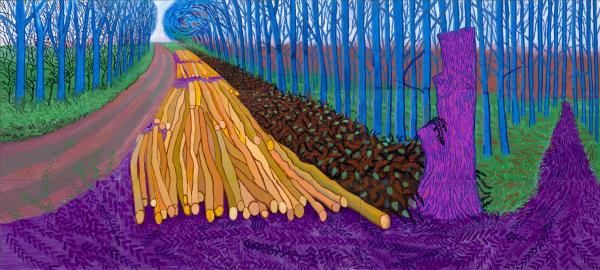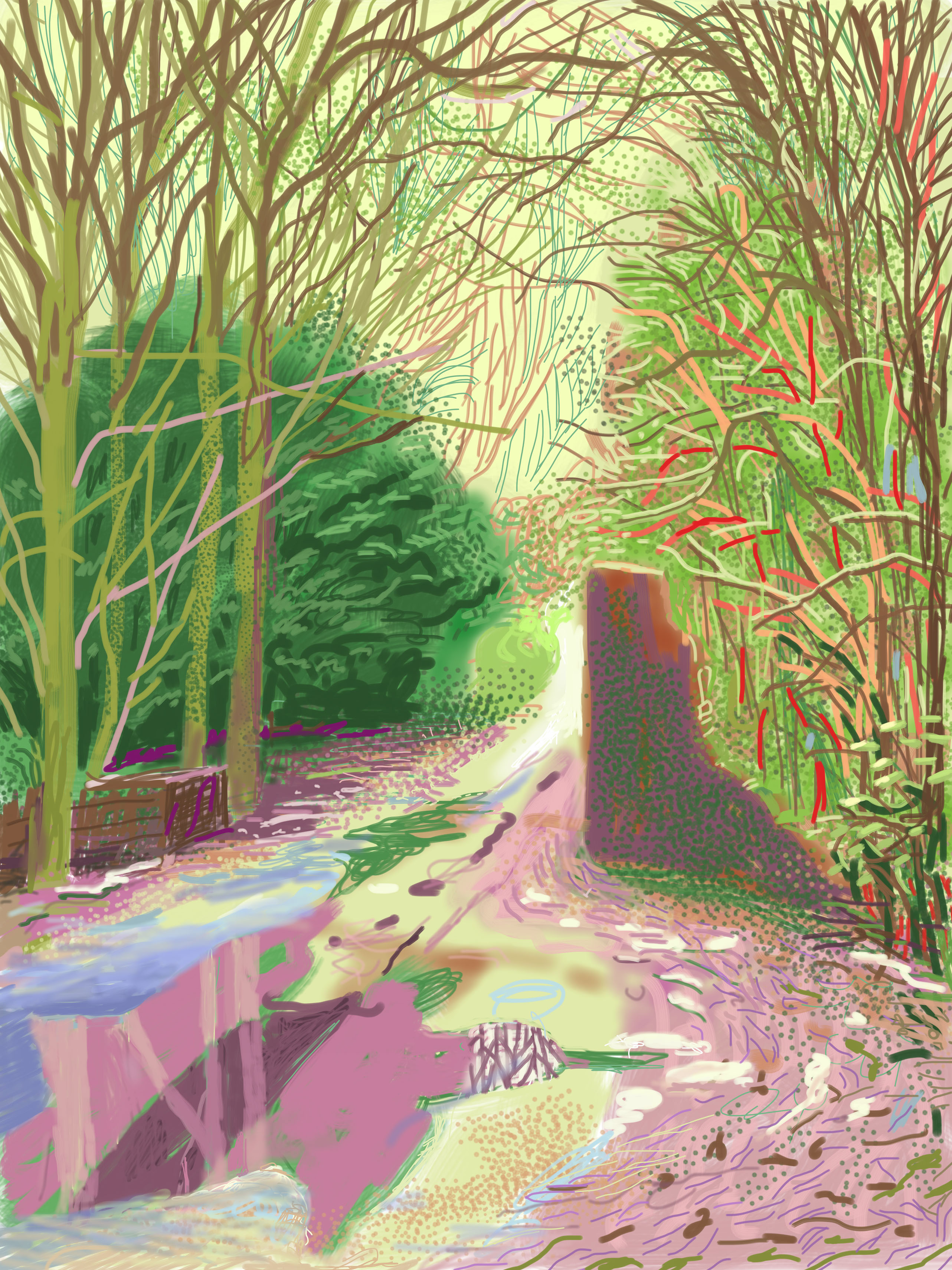David Hockney: A Bigger Picture, Royal Academy | reviews, news & interviews
David Hockney: A Bigger Picture, Royal Academy
David Hockney: A Bigger Picture, Royal Academy
Hockney goes bigger, closer, better with new works in oil and iPad

These are, we are told, David Hockney's landscape works, and in that they depict the outdoors - early Grand Canyons and LA scenes, Yorkshire from the Nineties to now - that is correct. As a description, however, it comes nowhere near encapsulating the mystical, profound, plain beautiful pictures presented at the Royal Academy.
The first paintings you encounter are both announcements of intention and tentative conclusions. These are seasonal versions of Three Trees Near Thixendale (2007-8), each nearly two metres by five, across eight canvases, capturing with elegant swoops bare purple-black branches in winter and the hesitant luxuriance of spring, summer's bursting fullness and autumnal decline. Spring has the sky of an Old Master even as thin, brief Post-Impressionist brushstrokes summon the fields.
These paintings, separately and together, give the most beautiful voice to Hockney's concern with the passing of time
Hockney is working in whichever mode takes his fancy because he can, and this is demonstrated time and again through the show: whether he is using an iPad for instant en plein air action or painting in oils from memory, as here, he never loses command. These pictures, whose age-old theme is refreshed by their beauty, have the consideration of a lifetime's painting and the energy for more. They, having gestated and evolved in his head, attaining mythical quality, predict the vibrancy of the new work even as they indicate Hockney's peaceful acceptance of a world beyond himself.
 Hurly-burly, aggression and panic are all but banished from the new work. A Closer Grand Canyon (1998) across its 60 panels feels anxious, only a narrow strip given to blue sky, its brushstrokes still slightly rough, its perspective vertiginous. There is meditation in the new work, even amid gaudy Fauvist colouring. Several of the paintings in the Winter Timber and Totems room, such as the monumental Winter Timber (2009) across 15 canvases (pictured above), with its somewhat grouchy be-faced bright purple tree stump, ochre logs lying along the receding road, brown ferns and blue trees, have a radiating cultic stillness. The purple-shading-to-yellow tree stump in Still Standing (2009) is a masterpiece of tone, as delicate in its deadness as anything here.
Hurly-burly, aggression and panic are all but banished from the new work. A Closer Grand Canyon (1998) across its 60 panels feels anxious, only a narrow strip given to blue sky, its brushstrokes still slightly rough, its perspective vertiginous. There is meditation in the new work, even amid gaudy Fauvist colouring. Several of the paintings in the Winter Timber and Totems room, such as the monumental Winter Timber (2009) across 15 canvases (pictured above), with its somewhat grouchy be-faced bright purple tree stump, ochre logs lying along the receding road, brown ferns and blue trees, have a radiating cultic stillness. The purple-shading-to-yellow tree stump in Still Standing (2009) is a masterpiece of tone, as delicate in its deadness as anything here.
As with the timber and tree stump, Hockney has tackled several scenes over and over and over again, a reaffirmation of the art of concentration best developed in Monet's Water Lilies. Particularly successful in this respect is the Woldgate Woods series (2006) (see main image). Painted from the same spot, Hockney has given them an audacious, challenging composition, with a confrontational tree almost pushing out of the foreground; it puts you into the picture, into Hockney's position, in an instant. There is then something very wonderful about the dotted foliage on the trees and on the floor, the inviting pale trunks and lithe shadows of the trees, the seasonal colourings and the path extending straight forward. These paintings, separately and together, give the most beautiful voice to Hockney's concern with the passing of time.
That includes the work made especially for the largest room in the Royal Academy, The Arrival of Spring in Woldgate, Easy Yorkshire in 2011 (twenty-eleven). 51 drawings, made on an iPad and then printed out on a bigger scale, capture different snapshots of Woldgate as spindly branches take on leaves and the sky lightens through countless shades of blue, and one immense painting, nearly 10 metres across, on 32 canvases, acts as supposed summation to them all.
Painted with a sure hand - there is no hesitation anywhere, in fact - it seduces you with its rich vision of spring, but is in fact less interesting than its companions, which show another medium Hockney has mastered. 2 January in this series (pictured left) shows the vivid colouration and the wide range of marks he can make on the iPad. The instant documents of the scene make the larger work almost too considered.
 Conversely, the new video works, made by strapping nine cameras, three by three, to a Jeep and slowly moving down Woldgate Woods, are depictions of an instant but are probably themselves too artificial. Hockney is making the point that he has done throughout his career, by using both multiple canvases for paintings and arrhythmic photocollages, that the real world cannot be captured from one angle by a "flat" work of art, indeed that there is no 'real' world, only our particular perception - but it feels more like a technical experiment here. He is doing in 2011 what Picasso did a century ago, adding nothing.
Conversely, the new video works, made by strapping nine cameras, three by three, to a Jeep and slowly moving down Woldgate Woods, are depictions of an instant but are probably themselves too artificial. Hockney is making the point that he has done throughout his career, by using both multiple canvases for paintings and arrhythmic photocollages, that the real world cannot be captured from one angle by a "flat" work of art, indeed that there is no 'real' world, only our particular perception - but it feels more like a technical experiment here. He is doing in 2011 what Picasso did a century ago, adding nothing.
For such bright and large works, for an artist obsessed with "bigger" and "closer", this is a remarkably quiet show. Hockney has mastered every type of painting he has turned his hand to, vied with his glorious predecessors and immersed himself in practically every leaf of his native landscape, once abandoned by him, now reclaimed. Yet Hockney, in his works here so persistently at war with the boundaries of painting, has no trouble turning this conflict into graceful, meditative works with a profound, almost moving love of place.
- David Hockney: A Bigger Picture is on at the Royal Academy until 9 April
Share this article
Add comment
The future of Arts Journalism
You can stop theartsdesk.com closing!
We urgently need financing to survive. Our fundraising drive has thus far raised £49,000 but we need to reach £100,000 or we will be forced to close. Please contribute here: https://gofund.me/c3f6033d
And if you can forward this information to anyone who might assist, we’d be grateful.

Subscribe to theartsdesk.com
Thank you for continuing to read our work on theartsdesk.com. For unlimited access to every article in its entirety, including our archive of more than 15,000 pieces, we're asking for £5 per month or £40 per year. We feel it's a very good deal, and hope you do too.
To take a subscription now simply click here.
And if you're looking for that extra gift for a friend or family member, why not treat them to a theartsdesk.com gift subscription?
more Visual arts
 'We are bowled over!' Thank you for your messages of love and support
Much-appreciated words of commendation from readers and the cultural community
'We are bowled over!' Thank you for your messages of love and support
Much-appreciated words of commendation from readers and the cultural community
![SEX MONEY RACE RELIGION [2016] by Gilbert and George. Installation shot of Gilbert & George 21ST CENTURY PICTURES Hayward Gallery](https://theartsdesk.com/sites/default/files/styles/thumbnail/public/mastimages/Gilbert%20%26%20George_%2021ST%20CENTURY%20PICTURES.%20SEX%20MONEY%20RACE%20RELIGION%20%5B2016%5D.%20Photo_%20Mark%20Blower.%20Courtesy%20of%20the%20Gilbert%20%26%20George%20and%20the%20Hayward%20Gallery._0.jpg?itok=7tVsLyR-) Gilbert & George, 21st Century Pictures, Hayward Gallery review - brash, bright and not so beautiful
The couple's coloured photomontages shout louder than ever, causing sensory overload
Gilbert & George, 21st Century Pictures, Hayward Gallery review - brash, bright and not so beautiful
The couple's coloured photomontages shout louder than ever, causing sensory overload
 Lee Miller, Tate Britain review - an extraordinary career that remains an enigma
Fashion photographer, artist or war reporter; will the real Lee Miller please step forward?
Lee Miller, Tate Britain review - an extraordinary career that remains an enigma
Fashion photographer, artist or war reporter; will the real Lee Miller please step forward?
 Kerry James Marshall: The Histories, Royal Academy review - a triumphant celebration of blackness
Room after room of glorious paintings
Kerry James Marshall: The Histories, Royal Academy review - a triumphant celebration of blackness
Room after room of glorious paintings
 Folkestone Triennial 2025 - landscape, seascape, art lovers' escape
Locally rooted festival brings home many but not all global concerns
Folkestone Triennial 2025 - landscape, seascape, art lovers' escape
Locally rooted festival brings home many but not all global concerns
 Sir Brian Clarke (1953-2025) - a personal tribute
Remembering an artist with a gift for the transcendent
Sir Brian Clarke (1953-2025) - a personal tribute
Remembering an artist with a gift for the transcendent
 Emily Kam Kngwarray, Tate Modern review - glimpses of another world
Pictures that are an affirmation of belonging
Emily Kam Kngwarray, Tate Modern review - glimpses of another world
Pictures that are an affirmation of belonging
 Kiefer / Van Gogh, Royal Academy review - a pairing of opposites
Small scale intensity meets large scale melodrama
Kiefer / Van Gogh, Royal Academy review - a pairing of opposites
Small scale intensity meets large scale melodrama
 Jenny Saville: The Anatomy of Painting, National Portrait Gallery review - a protégé losing her way
A brilliant painter in search of a worthwhile subject
Jenny Saville: The Anatomy of Painting, National Portrait Gallery review - a protégé losing her way
A brilliant painter in search of a worthwhile subject
 Abstract Erotic, Courtauld Gallery review - sculpture that is sensuous, funny and subversive
Testing the boundaries of good taste, and winning
Abstract Erotic, Courtauld Gallery review - sculpture that is sensuous, funny and subversive
Testing the boundaries of good taste, and winning
 Edward Burra, Tate Britain review - watercolour made mainstream
Social satire with a nasty bite
Edward Burra, Tate Britain review - watercolour made mainstream
Social satire with a nasty bite
 Ithell Colquhoun, Tate Britain review - revelations of a weird and wonderful world
Emanations from the unconscious
Ithell Colquhoun, Tate Britain review - revelations of a weird and wonderful world
Emanations from the unconscious

Comments
Thank you for this lovely
A fine review. There are some
Thanks for your considered
I live near the Yorkshire